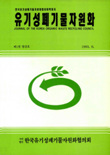학술논문
퇴비화과정종 생분해성 플라스틱의 분해 가능성 검토
이용수 498
- 영문명
- Investigation on Biodegradable Ability of Biodegradable Plastic in Composting
- 발행기관
- 유기성자원학회
- 저자명
- 박정수(Jeong-Soo Park) 배재근(Chae-gun Phae) 전영승(Young-Seung Jeon)
- 간행물 정보
- 『유기물자원화』제9권 제4호, 61~70쪽, 전체 10쪽
- 주제분류
- 공학 > 환경공학
- 파일형태
- 발행일자
- 2001.12.30
4,000원
구매일시로부터 72시간 이내에 다운로드 가능합니다.
이 학술논문 정보는 (주)교보문고와 각 발행기관 사이에 저작물 이용 계약이 체결된 것으로, 교보문고를 통해 제공되고 있습니다.

국문 초록
본 연구는 음식물 쓰레기의 퇴비화과정중에 생분해성 플 라스틱을 같이 넣었을 때, 실제적으로 생분해성 플라스틱이 분해가 이루어지면서 미생물의 활성이나 분해반응에 영향이 미치는지에 대하여 연구하였다. 본 연구에서 30%생분해성 플라스틱 6종류, 100%생분해성 플라스틱 4종류. 난 분해성 플라스탁 2종류가 시료로 사용되었고, 퇴비화반응은 온도 60~70 'C, 함수율 38~45% 의 양호한 조건에서 진행되었다. 무게 감량율은 30% 생분해성 플라스틱의 경우, 6개의 제품 중 4개의 제품이 15-25% 의 무게감량율을 보였으며 HDPE계열이 LLDPE계열보다 더 큰 감량율을 보였다. 물리적 특성에서도 난 분해성 플라스틱과 비교하여 신장율과 연장강도가 더 감소하였으며, LLDPE계열이 HDPE계열보다 더 큰 감소를 보였다. 이러한 현상은 LLDPE계열이 열에 약하기 때문인것으로 예측되었다. 100% 생분해성 플라스틱은 4개중 3개의 제품이 우수한 분해성을 보였고, 전자 현미경에 의한 표면 관찰결과에서 미생물에 의한 분해 흔적이 뚜렷하게 나타났다. 본 연구를 통해서 30% 생분해성 플라스틱은 분해가 되나 퇴비화반응 후에도 필름형태가 그대로 유지되기 때문에 음식물쓰레기 전용봉투로 사용되기에는
부적합하며, 100% 생분해성 플라스틱은 음식물쓰레기 전용봉투로 사용되기에 적합하나 제작비용이 높다는 점에서 생분해성 플라스틱이용의 대중화를 위해서 생산비용절감과 봉투 자체의 품질개선에 더욱 노력해야 할 것으로 사료된다.
영문 초록
This srudy investigated that biodegradable plastic is put for making compost from food waste, whether it influences
biodegradable response or activates microorganisms during compost process of raw biodegradable plastic in practice
Six rypes of 30% biodegradable plastic, four rypes of 100% biodegradablr plastic and rwo rypes of non biodegradable
pJastic were used for test material and compost response was processed at temperarure of 60 ~ 700c , 38~45% of water contents in good condition.
In case of 30% biodegradable plastics, four goods among six showed 15 ~25% of reduction rate of weight and
HDPE style showed bigger reduction rate than LLDPE. As compared ro non biodegradable pJastic, regarding physical
character had Jess strain at auto break and stress at max load and LLDPE rype showed bigger reduction than HDPE
rype. It is expected that this siruation was due ro LLDPE which is wealc in heat. Three goods among four of 100%
biodegradable plastic showed excel1ent degradation and it clearly showed that it was disimegrated by microorganisms in the result of observation of surface by electric microscope. 30% of biodegradable plastic was disintegrated but it mantained the ftlm style even mer compost response, therefore, it isn’t compatibJe ro use for exclusive bag for food waste. 100% biodegradabJe plastic was compatible to use for exclusive bag for food waste but manufacturing expenditure is high. Likewise, it is considered that we shouJd try ro develop quality of bag more and reduce manufacturing expenditure to popularize use ofbiodegradable plastic.
목차
1. 서론
2. 실험 재료 및 방법
3. 결과 및 고찰
4. 결론
참고문헌
해당간행물 수록 논문
- [특집]공생과 연계로 폐기물이라는 개념이 없는 순환사회구축
- [특집]자원순환사회의 정립을 위한 기본 정책방안
- 순천시 생활쓰레기의 계절별 조성 및 물리 · 화확적 특성에 관한 연구
- 남은음식물 퇴비 시용에 따른 토양의 이화학성 변화와 고추생육에 미치는 영향
- 지렁이 퇴비화 운영사례 및 개선방향
- 퇴비화과정종 생분해성 플라스틱의 분해 가능성 검토
- 음식물쓰레기 주입형태에 따른 혐기성 소화조의 메탄가스발생특성에 관한 연구
- [특집]음식물쓰레기의 자원 순환체제 구축방안에 대한 검토
- 음식물쓰에기의 자원화를 위한 배출업종별 정장 및 특정의 비교분석
- 상추에 대한 남은음식물 혐기 발효액의 시용효과
- 순천시의 생활폐기물 발생량 예측및 재활용시설의 용량산정에 관한 연구
- 유기 자연농업 실천농가의 기술 및 생산성 분석
- [특집]일본에 있어서 유기 폐기물 자원화의 현상과 과제
- [특집]순환형 자원화기술을 위한 경제성분석
참고문헌
교보eBook 첫 방문을 환영 합니다!

신규가입 혜택 지급이 완료 되었습니다.
바로 사용 가능한 교보e캐시 1,000원 (유효기간 7일)
지금 바로 교보eBook의 다양한 콘텐츠를 이용해 보세요!






